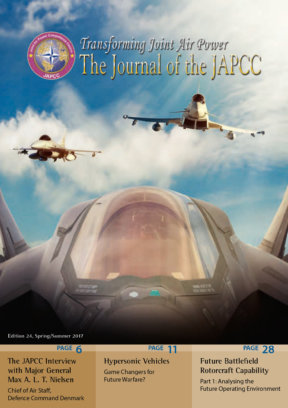Introduction to Maritime ISR
Maritime Patrol has existed since the early days of aviation and has been a critical part of nearly every NATO operation. Beginning with visual detection of naval task groups in the early part of World War II, the tactics for conducting surveillance at sea have evolved in concert with the sensors and the ability to communicate that intelligence in a timely manner to the users who need it. Evolutions in sensors and systems continue to change the way platforms at the Maritime Component level perform joint functions.
This article will discuss the Intelligence Surveillance Reconnaissance (ISR) capabilities of new Maritime Patrol Aircraft (MPA) platforms (the P-8A Poseidon and the MQ-4 Triton) and review how they link together as a network-enabled system to share not only intelligence, but also functions so they can operate together as an ISR team. This new way of integrating traditional MPA systems and functions for intelligence gathering will have an impact on ATP-102 (NATO Procedures for Maritime ISR), which is currently under development.
History of Maritime Patrol, Maritime Surveillance, and Maritime ISR
With the 1990s’ decrease in Air Power Contribution to Maritime Operations (APCMO)1 functions, such as Anti-Submarine Warfare, many MPA transformed into ISR platforms. These platforms gained improved electro-optics and imaging radar systems, coupled with enhancements to satellite communication and the ability to transmit live video and still images to other elements of the joint force. Consequently, these aircraft began operating not only as Maritime Surveillance platforms to keep track of naval contacts of interest, but as an integral part of the overall Joint ISR capability. As the P-3C Orion (for decades a workhorse in many nations’ MPA and ISR systems) reaches end-of-service-life, many NATO nations are rethinking the process by which Maritime ISR is conducted and migrating away from a platform-based philosophy to a system-of-capabilities model for intelligence gathering.
Maritime Patrol is commonly understood to encompass certain aspects of maritime intelligence gathering. An MPA can execute the full cycle of functions in the traditional Find, Fix, Track, Target, Engage, and Assess (F2T2EA) concept. Whereas some newer MPA are being built without kinetic capability (lacking either torpedoes or anti-ship missiles or both), their functions are limited to Maritime Surveillance (only FFT and A). Examples include the Polish Bryza and the common variants of the ATR-72 (ITA and TUR) and CASA 235 (ESP, IRE and TUR).2
Furthermore, many NATO nations modified their traditional MPA (P-3C Orion and MR2 Nimrod for example) with different sensor types dedicated to other collection disciplines such as Signals Intelligence (SIGINT) or its subset Communications Intelligence (COMINT), therefore precluding traditional MPA functions of naval target engagement. The US Navy previously had two complete squadrons of SIGINT-modified Orions, designated the EP-3 Aries, which saw more service in overland joint support roles than it did performing traditional overwater intelligence missions. The Aries, like many of its SIGINT counterparts in NATO, was not capable of carrying weapons and was relegated solely to an ISR role. To manage the growing demand on a dwindling number of airframes, in 2005 the US relocated Fleet Air Reconnaissance Squadron (VQ) 2, from Naval Air Station Rota, Spain, and in 2012 decommissioned the squadron.3 The Aries is approaching the end-of-service-life rapidly, and its intelligence capabilities will migrate to a set of both manned and unmanned replacement platforms rather than a single airframe.
Similarly, the P-3C Orion is also approaching end-of-service-life. At its height, variants of the Orion were flown by nine Alliance members, as well as eleven other non-NATO nations. Three NATO Nations have planned to migrate to the P-8 Poseidon Multi-Mission Aircraft (USA, GBR, NOR), while others have elected additional life extensions in lieu of replacement. But all have conducted significant upgrades to ISR systems (sensors and communications capability) as part of either replacement or life extension.
New MPA ISR Platforms within NATO Nations
1. The MQ-4 Triton. The MQ-4 Triton is a derivative of the RQ-4 Global Hawk airframe with sensors specifically designed for intelligence gathering in the maritime environment, such as the AN/ZPY-3 Multi-Function Active Sensor (MFAS) with a 360° field-of-regard active electronically scanned array (AESA) radar antenna.4 Furthermore, the payload comprises an electro-optical/ infrared (EO/IR) sensor, automatic identification system (AIS) receiver, and electronic support measures (ESM). The AN/ZLQ-1 ESM uses specific emitter identification (SEI) to track and detect emitters of interest. The MTS-B multispectral targeting system performs auto-target tracking and produces high-resolution imagery in multiple fields-of-view and full motion video.5 Communications relay and Link 16 integrate the Triton into the joint fight.6 With performance capabilities similar to the RQ-4 Global Hawk, which is the air vehicle of NATO’s Alliance Ground Surveillance (AGS) system, its long endurance and high altitude make it ideally suited for those traditional maritime intelligence functions of ‘detect’ and ‘track’ without consuming precious flight hours of manned surveillance aircraft which are needed for the kinetic end game. The Triton will be capable of sharing information in real time with both its manned partner, the P-8A Poseidon and with the NATO AGS Ground Station, allowing it to seamlessly integrate into NATO’s Joint ISR system. Eventually, the US is planning to purchase 68 Tritons.7
2. The P-8A Poseidon. The P-8A Poseidon not only brings all of the anti-submarine and anti-shipping capability of the Orion, but also expands significantly on its ISR and joint battlespace operations potential. In a departure from the Orion, all Poseidons will have Link 16, as well as upgraded electro-optics and imaging radar systems. In addition to the maritime imaging radar mounted in the nose, a future plan for the Poseidon is to carry the externally mounted AP/ANY-10 MTI imaging radar system (upgrade from the P-3’s Littoral Surveillance Radar System – LSRS), which adds both an overland and maritime MTI capability approaching the fidelity provided by the US Joint Surveillance and Target Attack Radar System (JSTARS). But these sensors are not much more advanced than those on the more modern P-3s; the true advance in the Poseidon is the ability to rapidly exchange and share information internally among the crew and externally among joint partners.
The US is planning to acquire 117 P-8A, with nine being purchased by GBR.8 Norway is exploring six Poseidons to replace their aged P-3 Orions. Outside NATO, Australia and India (eight planned by each) have already received their first airframes and interest is being expressed by many other nations as well.9 The Poseidon’s ability to integrate into the respective nation’s Joint intelligence system while providing real-time intelligence to afloat commanders, as well as real time targeting information to sea-based strike aircraft, is dramatically improving the link between maritime intelligence and aircraft carrier or amphibious operations.
The ‘Family of Systems’ Concept
The ‘Family of Systems’ concept is a perspective on ISR that changes from a platform-centric view to one based on capabilities spread over multiple platforms. This is an attempt to better integrate strategic ISR collection capabilities with those focused on the operational and tactical levels, as well as to integrate those platforms that can only perform some of the F2T2EA functions with those able to execute the remainder. The key to this family concept is interoperability and integration; the ability to share information.
The Triton program manager highlighted the relationship between the Triton and Poseidon in this way: ‘Say the Triton is out doing a mission somewhere in the world and defines a target of interest, and we decide we want to explore that further, you have the perfect scenario where you can stay on target, then call in or direct a P-8 to that area to do more work with different sensors. It takes the best capabilities of each and puts them together in the first manned/unmanned programme of its kind.’10 Future upgrades to the Poseidon envision the ability not only to target the enemy with the Poseidon’s own weapons, but also the ability to manage off-board sensors and weapons.11
The US Navy is even looking at the potential of adding in a carrier-based system to this family, linking the manned, land-based P-8A Poseidon with the Triton and the Unmanned Carrier-Launched Airborne Surveillance & Strike (UCLASS) drone.12 The UCLASS is a proposed, but not yet approved, unmanned carrier system that will serve as a tanker for carrier-based fighter aircraft and may also be fitted with ISR sensors to aid in maritime intelligence functions. However, the first iteration of the UCLASS, called the MQ-25 Stingray, will not yet include a strike capability.
The US Navy is electing to deviate from typical unmanned platform organization. Instead it plans to co-locate the Triton and Poseidon squadrons and co-man them. Tritons will ideally be operated by Poseidon aircrew serving in a subsequent ‘flying’ tour of duty. This allows a unique perspective into manned and unmanned teaming, as the operators will be versed in the tactics and sensor capabilities of the other in a unique way, having flown the Poseidon on multiple combat deployments prior to arrival at VUP-19 (the Triton squadron established in October 2016 in Jacksonville, Florida, and co-located with six Poseidon squadrons).13
Recommendations for the ATP-102 Writing Team
In 2014, Allied Maritime Command highlighted a growing disconnect between the Maritime Component and the Joint Intelligence (JINT) process and requested a study be conducted into the efficient use of future Maritime ISR. In October 2016, Allied Command Transformation accepted this request and stood up a writing team to develop ATP-102, NATO Procedures for Maritime ISR, in an effort to codify the link between maritime intelligence collection and the Joint ISR process.
As this article outlined, from a sensor perspective the future for Maritime Intelligence is likely not platform based. In fact, future Maritime Patrol Aircraft, including the Poseidon and Triton, will likely be directed and co-ordinated, in part, by the Joint Force Commander’s ISR collection management staff as often as they are managed by the Maritime Component Commander. Although this is done to some extent with ISR variants of MPA today, it is likely this role-sharing will grow in scope and complexity as new sensors and new MPA are developed. As these aircraft are capable of many simultaneous yet different functions both internal and external to the intelligence gathering process, the mechanism by which these platforms are exploited must be mutually beneficial to both the JFC’s Joint ISR requirements and the needs of the Maritime Component Commander.
As ATP-102 takes form, the writers should not discount the operational role of intelligence. Platforms that are principally intelligence gatherers, such as the Triton, must have a role supporting the Maritime Component in addition to serving in the Joint intelligence role. Multi-mission platforms, such as the Poseidon, which are capable not only of intelligence gathering to meet strategic and operational needs but also of the kinetic end game at the tactical level, must continue to serve both masters as well. The final version of the doctrine should inform commanders how best to exploit the existing Joint ISR procedures for Maritime operational level needs and codify how intelligence gathered at the tactical/operational level by various maritime platforms (above, on and under the sea) is pushed up into the joint process for multi-component exploitation.












